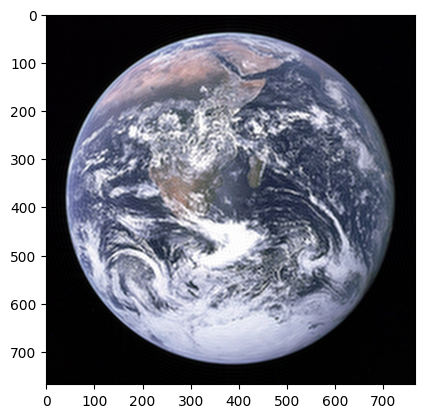Introduction to the FFT
Motivation
The discrete Fourier transform (DFT) is a transformation that converts a signal from its original domain (e.g., time or space) into a frequency domain. The DFT has widespread applicability (e.g., data compression, filtering, partial differential equations, etc.). However, if the DFT is computed naively, the amount of work required to transform a signal with $n$ elements is $O(n^2)$ FLOPs.
A fast Fourier transform (FFT) is any one of a family of algorithms that can compute the DFT in $O(n \lg n)$ FLOPs. The widespread adoption of the DFT is, without a doubt, due to the FFT.
This article introduces the theory of the DFT and FFT and gives some examples in Python.
Notation
$i$ denotes the imaginary unit. The complex conjugate of a complex number $z$ is denoted $z^\dagger$.
Throughout, this article, we fix our choice of $n$ and work with the complex vector space $\mathbb{C}^n$. When the vector space is not made explicit in writing, it should be assumed that it is this one. The conjugate transpose $\boldsymbol{z}^\mathrm{H}$ of a complex vector or matrix $\boldsymbol{z}$ is obtained by taking the ordinary transpose and conjugating each entry. An inner product is obtained by defining $\langle \boldsymbol{u}, \boldsymbol{v} \rangle = \boldsymbol{v}^{\mathrm{H}} \boldsymbol{u}$. The induced norm is $|\boldsymbol{u}| = \sqrt{\langle \boldsymbol{u}, \boldsymbol{u} \rangle}$.
The Kronecker delta $\delta_{jj^\prime}$ is defined to be one whenever $j = j^\prime$ and zero otherwise.
Discrete Fourier Transform
Roots of unity
Definition (Roots of unity). A complex number $z$ satisfying $z^n = 1$ is called an $n$-th root of unity.
Lemma. If $z$ is an $n$-th root of unity, so too is $z^u$ for any complex number $u$.
Proof. $z^u = (z^u)^n = z^{nu} = (z^n)^u = 1^u = 1.$
For the remainder, let $\omega = \exp(-2 \pi i / n)$.
Corollary. $\omega^0, \ldots, \omega^{n - 1}$ are the only $n$-th roots of unity.
Proof. It’s readily verified by direct computation that $\omega^0, \ldots, \omega^{n - 1}$ are distinct $n$-th roots of unity. Uniqueness follows from the fundamental theorem of algebra applied to $z^n - 1$.
Lemma. Let $n$ be a positive integer and $z \neq 1$ be an $n$-th root of unity. Then $z^0 + \cdots + z^{n - 1} = 0$.
Proof. The sum is a (finite) geometric series and hence $(1 - z) (z^0 + \cdots + z^{n - 1}) = 1 - z^n$, from which the desired result follows.
Forward and inverse transforms
Theorem. Let
\[\boldsymbol{f}^{(j)} = \frac{1}{\sqrt{n}} ( \omega^0, \omega^j, \omega^{2j}, \ldots, \omega^{(n - 1)j} ).\]Then, the vectors $\boldsymbol{f}^{(0)}, \ldots, \boldsymbol{f}^{(n - 1)}$ form an orthonormal basis for $\mathbb{C}^n$.
Proof. Let $j$ and $j^\prime$ be nonnegative integers strictly smaller than $n$. By the previous lemma,
\[n \left \langle \boldsymbol{f}^{(j)}, \boldsymbol{f}^{(j^\prime)} \right \rangle = \omega^{(j - j^\prime) \cdot 0} + \cdots + \omega^{(j - j^\prime) \cdot (n - 1)} = n \delta_{jj^\prime}\]as desired.
The above establishes that the matrix $F$ whose rows are $\boldsymbol{f}^{(0)}, \ldots, \boldsymbol{f}^{(n - 1)}$ is unitary. The matrix $F$ is called the forward transform. Because this matrix is unitary, its conjugate transpose $F^{\mathrm{H}}$ is its inverse. As such, we call the conjugate transpose the inverse transform.
Remark.
In the above, we used the scaling factor $n^{-1 / 2}$ to ensure that the matrix F was unitary, simplifying mathematical discussion.
The NumPy definitions of forward and inverse transforms do not use the same scaling factor (in particular, numpy.fft.fft uses $n^{1 / 2} F$ and hence the corresponding inverse transform numpy.fft.ifft uses $n^{-1 / 2} F^\mathrm{H}$ to ensure that the two functions are inverses of one another).
Software libraries have their own conventions when it comes to the scaling factors for forward and inverse transforms, so it’s best to proceed carefully!
For the remainder, we employ the convention that if $\boldsymbol{z}$ is a vector, then the uppercase symbol $\boldsymbol{Z}$ is its forward transform. That is, $\boldsymbol{Z} = F \boldsymbol{z}$.
Some immediate results
Theroem (Plancherel theorem). Let $\boldsymbol{u}$ and $\boldsymbol{v}$ be vectors. Then, $\langle \boldsymbol{u}, \boldsymbol{v} \rangle = \langle \boldsymbol{U}, \boldsymbol{V} \rangle$.
Proof. $\langle \boldsymbol{U}, \boldsymbol{V} \rangle = \langle F \boldsymbol{v}, F \boldsymbol{v} \rangle = \boldsymbol{v}^{\mathrm{H}} F^{\mathrm{H}} F \boldsymbol{u} = \boldsymbol{v}^{\mathrm{H}} \boldsymbol{u} = \langle \boldsymbol{u}, \boldsymbol{v} \rangle$.
Corollary (Parseval’s theorem). Let $\boldsymbol{u}$ be a vector. Then, $|\boldsymbol{u}| = |\boldsymbol{U}|$.
The above result simply states that the original vector and its transform have the same Euclidean norm.
Convolution
For integers $a$ and $b$ with $b$ nonnegative, denote $a \% b$ the least nonnegative residue of $a$ modulo $b$ (i.e., the usual definition of the operator % in many programming languages).
For a vector $\boldsymbol{u}$ with $n$ entries, we introduce the indexing convention $z_j = z_{j \% n}$ whenever $j$ is negative or at least as large $n$.
Definition (Circular convolution). The circular convolution of vectors $\boldsymbol{u}$ and $\boldsymbol{v}$ is a vector $\boldsymbol{u} \star \boldsymbol{v}$ with entries $(\boldsymbol{u} \star \boldsymbol{v})j = u_0 v{j - 0} + \cdots + u_{n - 1} v_{j - (n - 1)}$.
Denote by $\odot$ the element-wise product.
Theorem (Convolution theorem). Let $\boldsymbol{u}$ and $\boldsymbol{v}$ be vectors. Then, $F (\boldsymbol{u} \star \boldsymbol{v}) = \sqrt{n} (\boldsymbol{U} \odot \boldsymbol{V})$.
The above theorem tells us that the convolution of vectors $\boldsymbol{u}$ and $\boldsymbol{v}$ can be computed by
- computing the DFTs $\boldsymbol{U}$ and $\boldsymbol{V}$,
- multiplying these element-wise to get $\boldsymbol{Z} = \boldsymbol{U} \odot \boldsymbol{V}$, and
- computing the inverse Fourier transform of $\sqrt{n} \boldsymbol{Z}$.
Similar results can be established for the circular cross-correlation.
Real signals
In practice, the input to the forward transform is often a real signal (i.e., a vector in $\mathbb{R}^n$). It is useful to derive some facts about such signals.
Theorem (Conjugate symmetry). Let $\boldsymbol{x}$ be a vector in $\mathbb{R}^n$. Then, $X_j^\dagger = X_{n - j}$.
Proof. First, note that $\boldsymbol{X}^{\mathrm{H}}=(F\boldsymbol{x})^{\mathrm{H}}=\boldsymbol{x}^{\intercal}F^{\mathrm{H}}=((F^{\mathrm{H}})^{\intercal}\boldsymbol{x})^{\intercal}$. Using the fact that $(\omega^{kj})^{\dagger}=\omega^{-kj}=\omega^{k(n-j)}$, the $j$-th row of $(F^{\mathrm{H}})^{\intercal}$ is $f^{(n-j)}$, from which the result follows.
The above tells us that for a real input $\boldsymbol{x}$, we need only compute the first $1 + \lfloor n / 2 \rfloor$ coordinates of $\boldsymbol{X}$.
Remark.
The NumPy function numpy.fft.rfft takes advantage of this fact.
But what if we only have access to a “black box” function that computes the forward transform? Can we still save on computation? The answer is provided by the corollary below.
Corollary. Let $\boldsymbol{x}$ and $\boldsymbol{y}$ be two vectors in $\mathbb{R}^n$. Let $\boldsymbol{z} = \boldsymbol{x} + i\boldsymbol{y}$. Then, $2 X_j = Z_j + Z_{n - j}^\dagger$ and $2 i Y_j = Z_j - Z_{n - j}^\dagger$.
In other words, the DFT of two real inputs $\boldsymbol{x}$ and $\boldsymbol{y}$ can be computed by
- creating a complex signal $\boldsymbol{z}$ whose real part is $\boldsymbol{x}$ and whose complex part is $\boldsymbol{y}$,
- computing the DFT $\boldsymbol{Z}$, and
- retrieving the individual DFTs $\boldsymbol{X}$ and $\boldsymbol{Y}$ by the above formulas.
import numpy as np
def fft_of_two_real_signals(x: np.ndarray, y: np.ndarray):
"""Computes the FFT of two real signals using a single complex FFT.
Parameters
----------
x: A real NumPy vector.
y: A real NumPy vector.
Returns
-------
X: The FFT of x.
Y: The FFT of y.
"""
z = x + 1j * y
Z = np.fft.fft(z)
Z_reverse_conj = np.conjugate(np.concatenate([[Z[0]], np.flip(Z[1:])]))
X = (Z + Z_reverse_conj) * 0.5
Y = (Z_reverse_conj - Z) * 0.5j
return X, Y
Fast Fourier transform
The Cooley-Tukey algorithm is the most common FFT algorithm. It re-expresses the DFT of an arbitrary composite size $n = ab$ in terms of smaller DFTs of sizes $a$ and $b$.
Radix-2 algorithm
Assuming $n$ is even, the radix-2 algorithm corresponds to taking $a = b = n /2$. The motivation comes from notating that
\[\sqrt{n}X_{k} =\sum_{j=0}^{n-1}\omega^{jk}x_{j} =\sum_{j=0}^{n/2-1}\omega^{2jk}x_{2j}+\omega^{k}\sum_{j=0}^{n/2-1}\omega^{2jk}x_{2j+1}\]and hence $X_k = E_k + \omega^k O_k$ where $\boldsymbol{E}$ and $\boldsymbol{O}$ are DFTs of the even and odd parts of the original signal $\boldsymbol{x}$. By expressing this relationship recursively, we obtain a natural $O(n \lg n)$ algorithm to compute the DFT.
Image compression
Image compression is one possible application of the FFT. It can be achieved by
- transforming the image into the frequency domain,
- dropping high-frequency components, and
- saving the result.
To view the image, one must inverse transform back to the original domain.
Let’s try it on an example image.
Remark. There are much better ways to compress images; the code below is purely demonstrational.
import sys
import numpy as np
from PIL import Image
from numpy.fft import fft2, fftshift, ifft2, ifftshift
from scipy.sparse import csr_matrix
def compress_image(image: Image, frac: float) -> tuple[csr_matrix, csr_matrix, csr_matrix]:
"""Compress (lossy) an image.
Parameters
----------
image
A PIL image
frac
Fraction of frequency components to drop per axis
Returns
-------
A sparse matrix for each of the color channels (R, G, B)
"""
assert 0.0 <= frac <= 1.0
frac = 0.5 * (frac + 1.0)
# Convert the image to a numpy array and split into RGB channels
img_array = np.array(image)
r, g, b = img_array[:, :, 0], img_array[:, :, 1], img_array[:, :, 2]
# Perform FFT on each channel
r_fft = fft2(r)
g_fft = fft2(g)
b_fft = fft2(b)
# Shift zero-frequency component to center
r_fft_shifted = fftshift(r_fft)
g_fft_shifted = fftshift(g_fft)
b_fft_shifted = fftshift(b_fft)
# Compute the number of high-frequency components to keep based on the fraction
height, width = r.shape
cutoff_x = int(width * frac)
cutoff_y = int(height * frac)
# Zero out high-frequency components
def zero(arr):
arr[+cutoff_y:, :] = 0
arr[:-cutoff_y, :] = 0
arr[:, +cutoff_x:] = 0
arr[:, :-cutoff_x] = 0
zero(r_fft_shifted)
zero(g_fft_shifted)
zero(b_fft_shifted)
# Convert the frequency-domain data to CSR format (sparse matrices)
r_sparse = csr_matrix(r_fft_shifted)
g_sparse = csr_matrix(g_fft_shifted)
b_sparse = csr_matrix(b_fft_shifted)
# Calculate compression ratio
total_elements = r.size + g.size + b.size
non_zero_elements = r_sparse.nnz + g_sparse.nnz + b_sparse.nnz
compression_ratio = total_elements / non_zero_elements
# Print the compression ratio
print(f"Compression ratio: {compression_ratio:.4f}", file=sys.stderr)
return r_sparse, g_sparse, b_sparse
def uncompress_image(r: csr_matrix, g: csr_matrix, b: csr_matrix) -> Image:
"""Uncompress an image.
Parameters
----------
r
Compressed red channel
g
Compressed green channel
b
Compressed blue channel
Returns
-------
A PIL image
"""
r_fft_shifted = r.toarray()
g_fft_shifted = g.toarray()
b_fft_shifted = b.toarray()
r_reconstructed = np.abs(ifft2(ifftshift(r_fft_shifted)))
g_reconstructed = np.abs(ifft2(ifftshift(g_fft_shifted)))
b_reconstructed = np.abs(ifft2(ifftshift(b_fft_shifted)))
img_array = np.stack([r_reconstructed, g_reconstructed, b_reconstructed], axis=-1)
return Image.fromarray(np.uint8(np.clip(img_array, 0, 255)))
import requests
from io import BytesIO
import matplotlib.pyplot as plt
url = "https://upload.wikimedia.org/wikipedia/commons/thumb/9/97/The_Earth_seen_from_Apollo_17.jpg/767px-The_Earth_seen_from_Apollo_17.jpg"
response = requests.get(url)
original_image = Image.open(BytesIO(response.content))
plt.imshow(original_image);

r, g, b = compress_image(image=np.array(original_image), frac=0.25)
uncompressed_image = uncompress_image(r, g, b)
plt.imshow(uncompressed_image);
Compression ratio: 16.0628
